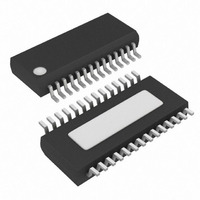MAX1977EEI+ Maxim Integrated Products, MAX1977EEI+ Datasheet - Page 25

MAX1977EEI+
Manufacturer Part Number
MAX1977EEI+
Description
IC CNTRLR PS QUAD HI EFF 28QSOP
Manufacturer
Maxim Integrated Products
Datasheet
1.MAX1977EEIT.pdf
(32 pages)
Specifications of MAX1977EEI+
Applications
Controller, Notebook Computers
Voltage - Input
4.5 ~ 24 V
Number Of Outputs
4
Voltage - Output
3.3V, 5V, 2 ~ 5.5 V
Operating Temperature
0°C ~ 85°C
Mounting Type
Surface Mount
Package / Case
28-QSOP
Output Voltage
3.3 V, 2 V to 5.5 V
Input Voltage
6 V to 24 V
Mounting Style
SMD/SMT
Maximum Operating Temperature
+ 85 C
Minimum Operating Temperature
- 40 C
Case
SSOP
Dc
06+
Lead Free Status / RoHS Status
Lead free / RoHS Compliant
The switching frequency (on-time) and operating point
(% ripple or LIR) determine the inductor value as follows:
Example: I
200kHz, 35% ripple current or LIR = 0.35:
Find a low-loss inductor having the lowest possible DC
resistance that fits in the allotted dimensions. Ferrite cores
are often the best choice. The core must be large enough
not to saturate at the peak inductor current (I
The inductor ripple current also impacts transient-
response performance, especially at low V+ - V
difference. Low inductor values allow the inductor cur-
rent to slew faster, replenishing charge removed from
the output filter capacitors by a sudden load step. The
peak amplitude of the output transient (V
function of the maximum duty factor, which can be cal-
culated from the on-time and minimum off-time:
where minimum off-time = 0.350µs (max) and K is from
Table 2.
The minimum current-limit threshold must be great
enough to support the maximum load current when the
current limit is at the minimum tolerance value. The val-
ley of the inductor current occurs at I
half of the ripple current; therefore,
where I
voltage divided by the R
For the MAX1777/MAX1977/MAX1999, the minimum
current-limit threshold voltage is 93mV (ILIM_ = V
Use the worst-case maximum value for R
the MOSFET N2/N4 data sheet and add some margin
for the rise in R
V
SAG
I
LIMIT(LOW)
I
=
PEAK
L
LIMIT(LOW)
2
=
×
Supply Controllers for Notebook Computers
LOAD(MAX)
12
(
= I
∆
L
C
High-Efficiency, Quad Output, Main Power-
V
I
LOAD MAX
OUT
> I
LOAD(MAX)
=
DS(ON)
×
Determining the Current Limit
LOAD(MAX)
V
200
______________________________________________________________________________________
×
5 12
(
+ × ×
= minimum current-limit threshold
V
V
V
OUT
OUT
(
kHz
= 5A, V+ = 12V, V
f LIR I
with temperature. A good gener-
)
)
V
2
_
_
DS(ON)
+ [(LIR/2) x I
(
−
×
×
⎡
⎢
⎢
⎣
V
K
5
- [(LIR / 2) x I
0 35
⎛
⎜ ⎜
⎝
+ −
V
L K
×
.
V
⎛
⎜ ⎜
⎝
)
LOAD MAX
Inductor Selection
+ −
V
of N2/N4 (MAX1999).
V
OUT
×
OUT
V
V
V
(
+
5
+
OUT
A
_
LOAD(MAX)
LOAD(MAX)
_
)
=
+
OUT5
_
)
SAG
LOAD(MAX)
8 3
t
PEAK
⎞
⎟ ⎟ −
⎠
OFF MIN
. µ
DS(ON)
) is also a
t
H
(
OFF MIN
= 5V, f =
):
]
minus
(
)
OUT_
from
⎞
⎟ ⎟
⎠
CC
]
)
).
⎤
⎦
al rule is to allow 0.5% additional resistance for each °C
of temperature rise.
Examining the 5A circuit example with a maximum
R
7.75A is greater than the valley current of 4.125A, so
the circuit can easily deliver the full-rated 5A using the
fixed 100mV nominal current-limit threshold voltage.
Connect the source of the synchronous rectifier to a
current-sense resistor to GND (MAX1777/MAX1977),
and connect CS_ to that junction to set the current limit
for the device. The MAX1777/MAX1977/MAX1999 limit
the current with the sense resistor instead of the
R
resistor can be calculated with the equation
The output filter capacitor must have low enough equiv-
alent series resistance (ESR) to meet output ripple and
load-transient requirements, yet have high enough ESR
to satisfy stability requirements. The output capaci-
tance must also be high enough to absorb the inductor
energy while transitioning from full-load to no-load con-
ditions without tripping the overvoltage fault latch. In
applications where the output is subject to large load
transients, the output capacitor’s size depends on how
much ESR is needed to prevent the output from dip-
ping too low under a load transient. Ignoring the sag
due to finite capacitance:
where V
drop. In non-CPU applications, the output capacitor’s
size depends on how much ESR is needed to maintain
an acceptable level of output voltage ripple:
where V
The actual capacitance value required relates to the
physical size needed to achieve low ESR, as well as to
the chemistry of the capacitor technology. Thus, the
capacitor is usually selected by ESR and voltage rating
rather than by capacitance value (this is true of tanta-
lum, OS-CON, and other electrolytic-type capacitors).
DS(ON)
DS(ON)
I
LIMIT(LOW)
DIP
= 12mΩ at high temperature reveals the following:
P-P
of N2/N4. The maximum value of the sense
is the maximum tolerable transient voltage
is the peak-to-peak output voltage ripple.
R
= 93mV / 12mΩ > 5A - (0.35 / 2) 5A
ESR
I
LIM_
R
ESR
7.75A > 4.125A
Output Capacitor Selection
≤
= 93mV / R
LIR
≤
I
LOAD MAX
×
V
V
I
LOAD MAX
DIP
P P
(
−
SENSE
(
)
)
25











